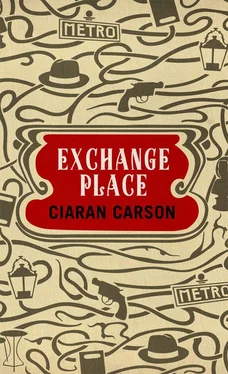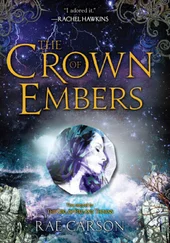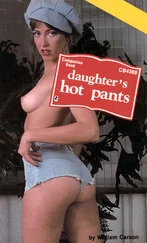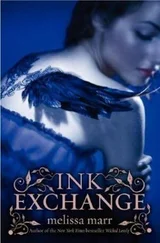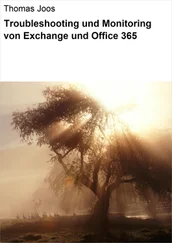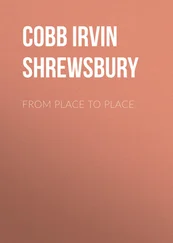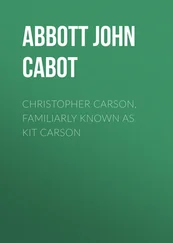I put the photographs and Harland’s notebook into my briefcase. As I descended the staircase, my footsteps echoed in the stairwell as they had done many times in the past, often syncopated by his footsteps as he clattered down before or after me, and images of Harland flitted through my mind: Harland going through my pockets, Harland twiddling the knobs of the EKO radio as it gave out a fizz of static between bursts of unintelligible languages, Harland’s smile as he gave me the Japanese box. When I reached the ground floor, the door of Federman’s shop was locked. I was about to slip the key to the attic under his door when I thought better of it, and pocketed it. I emerged from 14 Exchange Place to find the bright October day had turned dark. Storm clouds had gathered overhead. As I stepped into the entry there was a flash of lightning followed by a roll of thunder. It began to pour rain. I stepped back into the vestibule for shelter, remembering a passage in X + Y = K that had been prompted by a thunderstorm, or rather by Harland’s recollection of a thunderstorm.
It began with his showing me a View-Master 3D disc of London, one of a dozen he had picked up in a junkshop, together with the accompanying viewer. One image showed the interior of the revolving restaurant of the Post Office Tower, which had closed, never to be reopened, after a terrorist bomb had exploded in the building on Hallowe’en, 1971. As I put the binocular device to my eyes I experienced again the dreamlike exaltation that comes when surrounding objects are shut out by the concentration of our whole attention, in which we seem to leave the body behind and sail into one strange scene after another, like disembodied spirits. In foreground of the View-Master image, a man held a cup about six inches from his pursed lips. Behind him a woman held a knife about to cut the bread roll she held in her other hand. A pre-school child held a menu, his mouth open as if pretending to read. A waitress’s pencil was poised over an unwritten-on page. In this eternal moment, everyone seemed oblivious to the camera, except for one man standing with his back to the panoramic window, his head raised as if he had just that moment become aware of the photographer. Isn’t there something eerie about him, said Harland, something which doesn’t quite fit? You see the way nobody else seems aware of him, it’s as if they’re blind to him, or he’s invisible. And indeed there was something incongruous about his presence among these conventionally dressed diners. I noted again the electric blue sharkskin suit, the snap-brim trilby pulled down over his forehead, the dark glasses turned in my direction so that I felt he was eyeing me directly through space and time.
As it happens, said Harland, I was in the restaurant the day before the bomb. A complete revolution took about twenty minutes, he said, and it occurred to me that the restaurant was itself a kind of timepiece, its movement like that of a minute hand, just about perceptible if you watched it closely. At one point I looked out and saw the twin towers of Wembley stadium glimmering on the horizon in a lake of mustard yellow under a purple sky. Thunder was in the air, and there was a biblical quality about the light that made the towers look like those of Nineveh or Babylon. I thought of the Turner landscapes I had seen that morning in the National Gallery. When I looked out again I found myself overlooking Westminster, almost face to face with Big Ben, as it were. It was fourteen minutes to one o’clock; as I looked at the clock face, the big hand leaped forward a fraction, and the sky above the clock tower was rent by a great flash. A split second later an almighty roll of thunder shook the windows. Rain poured down upon the city, which began to take on a curious underwater aspect, the streets appearing like the galleries of a coral reef, cars with their headlights switched on gliding like electric fish. It was quite exhilarating, said Harland. I felt like Captain Nemo in the observation chamber of the Nautilus . As Harland spoke I imagined the rain streaming down the windows, making them waver like shot silk, and I recognized the beginning of a migraine aura, I wrote in X + Y = K .
In fact I had not suffered from migraine since my teens but I had vivid memories of its effects. Migraine is not a simple headache. Rather, it is an aggregate of innumerable components, of which headache is only one; and it cannot be identified with any one symptom. Migraine headache is often described as a violent throbbing pain in one temple, but it can be located anywhere in the head, in the teeth, at the base of the nose, in the neck, as far down as the tip of the shoulder; in some cases, it may seem exteriorised, as in an extra phantom limb, or head. In extreme cases the migraineur sometimes feels he has an invisible body double. Common to many experiences of migraine is the aura, a term first applied to the sensory hallucinations immediately preceding certain epileptic seizures. The aura which precedes the migraine headache takes many forms, including deficits of speech and thought, muddled space-perception, and a variety of dreamy, delirious, and trancelike states. On closing the eyes, some patients experience a visual tumult or delirium, in which latticed, faceted and tessellated motifs predominate — images resembling mosaics, honeycombs, or Turkish rugs. These evanescent figments tend to be brilliantly luminous, coloured, highly unstable, and liable to sudden kaleidoscopic transformations. Occasionally these structures generate maps of enormous cities, as might be seen at night from a surveillance helicopter, with ring roads and radial spokes, illuminated, looking like giant spider-webs of light.
Sometimes the patient loses an entire half of his field of vision. It seems to him that half of the world has disappeared, or that it was never there in the first place, and he is gripped by a feeling of incomprehensible, overwhelming loss. Yet in other instances the experience is one of enlightenment. I remember when I was about thirteen or so, cycling along a country lane. Suddenly I feel as if I have lived this moment before, in the same place, though I have never travelled this road before. An extraordinary feeling of stillness comes upon me. This summer afternoon has always existed; I am arrested in an endless moment. I stop. My hands, my lips, my nose, my tongue are tingling. The sensation spreads through my whole body. Now it affects my eyes. As I look at the trees, the grass, the clouds, they exhibit a silent boiling. Everything is quivering and streaming upwards in a kind of ecstasy, the hum of crickets all around like a buzz of colour corresponding to the sound I hear. My body is vibrating to everything around me.
Standing in the vestibule of 14 Exchange Place, watching the rain pour down, I felt an overwhelming nostalgia. In my mind’s eye I hovered above that scene of half a century ago, watching over the person I was then as if he were someone else, a thirteen-year-old boy who stands entranced by everything around him, not knowing or caring what will become of him in the years that lie ahead, for all that matters is now.
The black limousine was waiting. Gordon and Kilpatrick seated themselves in the passenger cabin. The limousine drove off into the night. The book, said Gordon, let’s call it X for now, open it. At random. Kilpatrick did as he was told. He opened the book at page 287. Read the first sentence, said Gordon. Kilpatrick read: In 1912 Edmund Edward Fournier d’Albe invented the optophone, which, by converting the light refracted from a page of printed matter into musical notes, enabled a blind person to read. Gordon clapped his hands together. Capital! he cried. You might say it is coincidence that we read about the blind on our way to see a blind man. But in our line of work there are no coincidences. You know the way you sometimes enter a library, in search of information; you’ve no idea where to begin looking, and yet something directs you to a particular shelf, to take down a particular book, for no good reason as far as you can tell, but it turns out to be the very book you need. And often the first sentence you read is just what you’ve been looking for, though you didn’t know it until then. Some call this phenomenon the Library Angel. But there are those amongst us who prefer to ascribe it to the work of the Invisibles. We call such passages of text Unseens. As it happens, John Bourne has developed a modified optophone for his painting. Essentially a simple concept, you translate colour wavelength into sound wavelength, I don’t know the exact correspondences, say the note C is white, F-sharp black, G red, and so on through the spectrum. So you can see, or rather hear, that a work by John Bourne is a musical experience as well as a visual one. And of course the converse is true, you can translate sound into colour. Come to think of it, you could translate anything into anything. Scent, taste, whatever. You could have an aromaphone, for example. Anyway, Bourne’s working on a series at present, Bach’s The Art of Fugue .
Читать дальше
